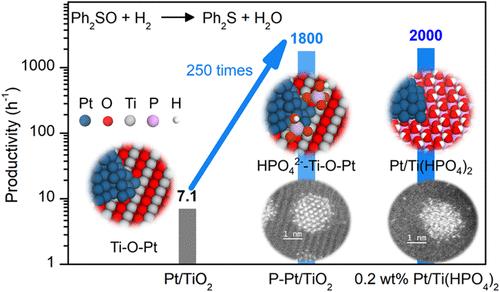磷酸盐通过促进金属-载体界面上的质子/电子转移来促进催化加氢脱氧
IF 15.6
1区 化学
Q1 CHEMISTRY, MULTIDISCIPLINARY
引用次数: 0
摘要
含氧化合物的催化加氢和脱氧在合成中起着至关重要的作用。尽管发展了许多氢脱氧(HDO)反应,但许多反应仍然依赖于化学计量还原剂,导致不良副产物和低原子效率。氢气已成为一种环保的替代品,但在温和条件下,其有效利用仍然具有挑战性。在这项研究中,Pt/TiO2的直接磷酸修饰导致亚砜HDO活性显著提高~ 250倍。由于Ti - po4 - Pt界面的存在,Pt/Ti(HPO4)2催化剂表现出比原始Pt/TiO2高280倍的生产率,超过其他均相和非均相催化剂的数量级。在原子尺度上阐明了配位不饱和Ti3+、界面磷酸盐和铂的关键作用,强调了界面上促进质子/电子转移的重要性。这项工作为可持续的催化加氢工艺提供了一种有前景的策略,在有机合成中具有广泛的适用性。本文章由计算机程序翻译,如有差异,请以英文原文为准。

Phosphate Boosts Catalytic Hydrodeoxygenation by Facilitating Proton/Electron Transfer at the Metal–Support Interface
Catalytic hydrogenation and deoxygenation of oxygenated compounds play an essential role in the synthesis. Despite the development of numerous hydrodeoxygenation (HDO) reactions, many reactions still rely on stoichiometric reducing agents, resulting in undesirable byproducts and a low atomic efficiency. H2 has emerged as an environmentally friendly alternative, but its efficient utilization remains challenging under mild conditions. In this study, the straightforward phosphate modification of Pt/TiO2 led to a remarkable ∼250-fold enhancement in the sulfoxide HDO activity. Owing to the presence of the Ti–PO4–Pt interface, the Pt/Ti(HPO4)2 catalyst exhibited an impressive ∼280 times higher productivity than pristine Pt/TiO2, surpassing other homogeneous and heterogeneous catalysts by orders of magnitude. The critical roles of coordinatively unsaturated Ti3+ sites, interfacial phosphate, and platinum were elucidated at the atomic scale, highlighting the significance of facilitated proton/electron transfer at the interface. This work offers a promising strategy for sustainable catalytic hydrogenation processes with broad applicability in organic synthesis.
求助全文
通过发布文献求助,成功后即可免费获取论文全文。
去求助
来源期刊
CiteScore
24.40
自引率
6.00%
发文量
2398
审稿时长
1.6 months
期刊介绍:
The flagship journal of the American Chemical Society, known as the Journal of the American Chemical Society (JACS), has been a prestigious publication since its establishment in 1879. It holds a preeminent position in the field of chemistry and related interdisciplinary sciences. JACS is committed to disseminating cutting-edge research papers, covering a wide range of topics, and encompasses approximately 19,000 pages of Articles, Communications, and Perspectives annually. With a weekly publication frequency, JACS plays a vital role in advancing the field of chemistry by providing essential research.

 求助内容:
求助内容: 应助结果提醒方式:
应助结果提醒方式:


